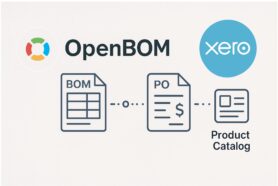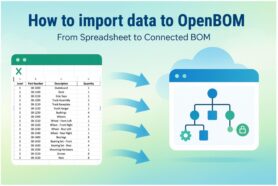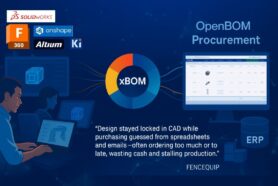
After a short break, I’m excited to continue my 30-Day OpenBOM Blogging Challenge — a journey to explore OpenBOM, its technology, and the people who use it to transform their work.
Today’s post is one of my favorites because it focuses on real customer stories. Nothing tells the OpenBOM story better than hearing directly from the engineers, managers, and innovators who moved beyond spreadsheets to organize their product data, connect engineering with procurement, and bring clarity to complex manufacturing processes.
Introduction – From Spreadsheets to Clarity
Every digital transformation story in manufacturing begins with a spreadsheet.
In the early stages of a product’s life, managing part lists and assemblies in Excel seems natural—simple, flexible, and familiar. But as soon as complexity enters the picture—more people, more revisions, multiple suppliers—the spreadsheet becomes a fragile bridge between engineering and the rest of the business.
The result? Missed updates. Duplicated files. Conflicting versions. A purchasing manager ordering from an outdated list. A production line waiting for parts that were never ordered.
At OpenBOM, we’ve seen this story unfold across hundreds of companies. From high-tech robotics startups to established electronics manufacturers, the same pattern emerges: spreadsheets don’t scale when your business depends on accurate, connected product data.
In today’s post, I want to highlight five real-world customer stories—VarTech Systems, rf IDEAS, SOLWR, Pyka, and Xponent Power. Each company started with Excel, faced the pain of disconnection, and ultimately found a better way with OpenBOM.
These are not abstract case studies—they’re practical examples of engineers and operations teams transforming their work with a platform built to connect CAD, BOM, and business processes in one collaborative space.
The Common Challenge – Life in Spreadsheets
Before moving to OpenBOM, all five companies shared the same foundation: product data trapped inside spreadsheets and email threads.
On the surface, Excel looked like a perfect tool—it was flexible, accessible, and required no setup. But underneath that simplicity, small cracks began to appear:
- BOMs were stored on local drives or cloud folders with names like “BOM_Final_v3.1.xlsx.”
- Engineers edited files simultaneously, overwriting each other’s changes.
- Procurement worked from old versions, leading to wrong part numbers and mismatched revisions.
- There was no visibility into where-used relationships or change history.
Every update required manual effort—export from CAD, paste into Excel, and email to purchasing. The cycle repeated endlessly.
As one customer told me, “We didn’t realize how much time we were losing until we saw how fast it could be.”
Let’s look at how five very different organizations—different industries, different products—solved the same problem: getting organized and connecting their data from engineering to business.
1. VarTech Systems – From Daily Excel Edits to Automated BOMs
VarTech Systems designs and manufactures industrial displays and computing equipment—rugged, high-performance devices built for tough environments.
For years, their engineering team managed product data manually. Every new project involved multiple spreadsheets, and each engineer spent hours updating BOMs, verifying revisions, and communicating changes to purchasing.
Then came the moment of realization: Excel had become a bottleneck.
After implementing OpenBOM, VarTech began creating BOMs directly from CAD. Every item automatically linked to a shared catalog, eliminating repetitive data entry and reducing errors.
Max, an engineer at VarTech, summed up the experience perfectly:
“OpenBOM easily saves us two hours a day in engineering time.”
“I remember we caught a $1000 mistake the first month we had OpenBOM. Our Excel had not been updated. OpenBOM literally paid for itself that month.”
“It’s all about the mistake WE DON’T make.”
By connecting CAD to OpenBOM, VarTech replaced dozens of disconnected spreadsheets with a single, dynamic system. BOMs updated automatically, purchasing always had the latest information, and engineers stopped wasting time managing data instead of designing products.
2. rf IDEAS – Streamlining Collaboration with Contract Manufacturers
rf IDEAS, based in Chicago, builds secure card readers and identification solutions used by global enterprises. Their products combine electronic components, firmware, and mechanical assemblies—an environment where precision and version control are critical.
Like many manufacturers, rf IDEAS relied on spreadsheets to manage product data and communicate with contract manufacturers (CMs). Each revision required another spreadsheet version, leading to confusion about which file reflected the latest change.
Craig Zerwas, Engineering & Operations Manager at rf IDEAS, described the breakthrough after adopting OpenBOM:
“Our primary use of OpenBOM is with our contract manufacturers. OpenBOM delivers the proper information to our CMs—it’s just that simple.”
With OpenBOM, the company consolidated all design and manufacturing data in one workspace—effectively creating what Craig called an “ERP-lite environment.” CMs accessed live, up-to-date information directly from OpenBOM instead of receiving static Excel files via email.
And one feature quickly became a team favorite:
“Everyone absolutely loves the where-used operation in OpenBOM. You just can’t do a where-used operation in an Excel BOM. It is impossible.”
By transitioning from spreadsheets to structured, collaborative BOMs, rf IDEAS strengthened supplier communication, reduced mistakes, and shortened production cycles.
3. SOLWR – Managing Multidisciplinary Data in an All-Cloud Environment
Norway-based SOLWR (formerly Currence Robotics) develops robotic and automation solutions for the renewable energy sector. Their products blend mechanical, electrical, and software systems, requiring seamless collaboration between multiple disciplines.
Initially, SOLWR managed their product data in Onshape for design and Excel for company-wide sharing. But as they scaled from prototypes to production, the inefficiency became impossible to ignore.
“We were constantly updating and emailing Excels with changes as we transitioned from proto builds to production planning,” recalls Eivind, one of SOLWR’s engineering leads.
Their shift to OpenBOM came naturally, aligned with their “all-cloud philosophy.”
“Accessibility and scalability are key,” says Eivind. “We have many people involved in critical business activities, and all must have access to the live Bill of Materials without reliance on email or Excel.”
Using OpenBOM’s deep integration with Onshape, SOLWR connected all design metadata into a single platform accessible to engineers, planners, and production teams.
“We saw the opportunity to leverage all metadata in Onshape but needed an organized way to bring it to the company (many of which were not engineers). With OpenBOM we get the very reliable Onshape integration AND the ability to extend the data as it flows through the company.”
Today, SOLWR uses OpenBOM as a shared digital backbone connecting engineering and operations—no spreadsheets required.
4. Pyka – Managing Complexity in Autonomous Aircraft Manufacturing
When you’re building autonomous electric aircraft, precision and synchronization aren’t optional—they’re mission-critical.
Pyka, a California-based startup, develops autonomous, zero-emission airplanes designed for agricultural and cargo applications. Their engineering process involves thousands of parts, dozens of sub-assemblies, and coordination between two distinct teams—engineering and manufacturing.
Initially, they tracked all this in Google Sheets. But as the company grew, spreadsheets simply couldn’t keep up.
“Our airplanes have lots of parts and assemblies to keep track of across two distinct teams—engineering and manufacturing—and we need to be on the same BOM all of the time. Getting all of that info straight was a big problem, and Google Sheets wasn’t going to get us there,” says Garrett Rini, Lead Mechanical Engineer at Pyka.
The company adopted OpenBOM to establish one source of truth for all product data.
“Moving from prototyping to production manufacturing is really hard,” Garrett adds. “We needed to button down parts, assemblies, and procedures and pass that information along to manufacturing.”
With OpenBOM, Pyka now maintains a single, authoritative BOM that updates automatically as design data evolves. Manufacturing teams always know what’s current, and costly mistakes from outdated spreadsheets are a thing of the past.
5. Xponent Power – Bringing Order to Sustainable Energy Manufacturing
Xponent Power builds lightweight, retractable solar panels for RVs and off-grid power systems—a fusion of sustainable design and cutting-edge engineering.
Like many early-stage hardware startups, Xponent Power began with email threads and shared spreadsheets. For a while, it worked. But as their product matured and complexity grew—more parts, more vendors, more revisions—these tools became bottlenecks.
“Like many early-stage companies, Xponent Power initially relied on emails and spreadsheets to manage product data. But as the product matured and complexity grew, these methods quickly became bottlenecks.”
To regain control, Xponent Power implemented OpenBOM as a cloud-native data backbone for their engineering and manufacturing processes.
What started as a simple way to organize BOMs soon evolved into the foundation of their operations:
“OpenBOM has become the core foundation for organizing product information and processes at Xponent Power,” their team shared.
With OpenBOM, they eliminated redundant manual work, ensured accurate data flow from design to procurement, and gave every team access to real-time information. The result? Fewer errors, faster production cycles, and a unified view of their entire product lifecycle.
Shared Lessons – From Chaos to Connected Operations
Although these five companies work in different industries—industrial electronics, secure identification, robotics, aerospace, and renewable energy—their stories converge around a few powerful lessons:
1. Spreadsheets are Flexible… Until They Break
Excel is often the first system of record for product data. It’s easy to start but hard to scale. Once multiple people edit the same data, version conflicts, broken formulas, and miscommunications are inevitable.
2. Data Silos Kill Collaboration
When engineering and purchasing operate in separate systems, valuable design data stays hidden. Procurement relies on outdated exports, leading to wrong orders, late shipments, and expensive corrections.
3. Integration Is the Turning Point
Each customer’s transformation began the moment they integrated CAD with OpenBOM. Real-time updates replaced manual exports, and suddenly everyone—from engineers to buyers—was working from the same live data.
4. Visibility Builds Confidence
Features like “where-used,” version history, and catalog linking gave teams a level of visibility they never had in spreadsheets. Engineers knew exactly which assemblies used a part; procurement knew what to order and when.
5. Fewer Mistakes = Faster ROI
As VarTech’s Max put it: “It’s all about the mistake WE DON’T make.” Catching a $1,000 error in the first month isn’t an exception—it’s the rule. Each avoided mistake compounds into time saved, smoother operations, and measurable ROI.
The Bigger Picture – A Digital Thread from Engineering to Business
At the heart of all five stories is a single idea: engineering data has business value.
When engineering and procurement share the same source of truth, decisions become faster and more accurate. Teams collaborate, not just communicate. Manufacturing can plan ahead instead of reacting to errors.
OpenBOM’s mission has always been to make this connection effortless—to open engineering information to the rest of the organization. Whether it’s through CAD integrations, catalog management, purchasing tools, or ERP connectivity, OpenBOM provides the infrastructure for a continuous digital thread from design to order.
The journey from spreadsheets to OpenBOM is not about replacing one tool with another—it’s about building product memory that grows with your business.
Each customer featured here took the first step toward that connected future, and their stories show that transformation is possible—without complexity, without big-system overhead, and without losing the agility that makes small and mid-sized manufacturers thrive.
Conclusion – One Platform, Many Journeys
VarTech saved two hours a day. rf IDEAS made data sharing with contract manufacturers effortless. SOLWR scaled multidisciplinary robotics development entirely in the cloud. Pyka synchronized its teams building autonomous airplanes. Xponent Power built a sustainable energy product with a sustainable process.
Different products, same foundation: organized, connected, and collaborative product data.
The lesson across all five stories is clear—when you stop managing spreadsheets and start managing information, everything changes.
REGISTER FOR FREE and check how OpenBOM can help you.
PS. In Day 7 of this series, we’ll look at how OpenBOM’s collaboration capabilities extend beyond company boundaries, enabling engineers, suppliers, and partners to work together in real time.
Best, Oleg
Join our newsletter to receive a weekly portion of news, articles, and tips about OpenBOM and our community.









